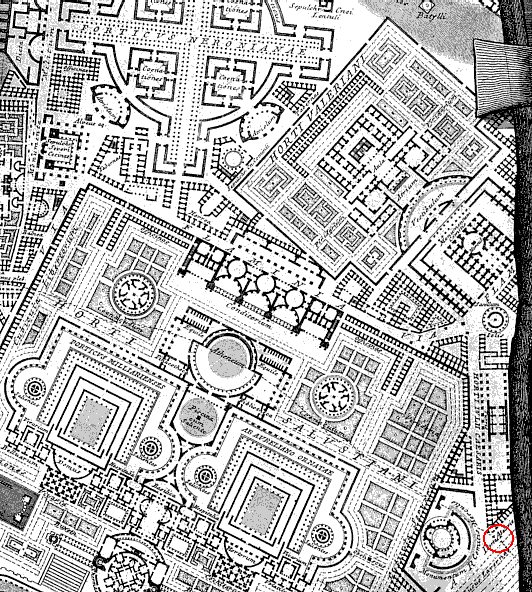Platner 116
Vincenzo Fasolo, "The Campo Marzio of G. B. Piranesi".
2691a
1956
Visigothic seige
"Thus began the third Visigothic siege, actually blockade, of Rome, an event whose outcome, after some eight centuries in which the imperial City had known impunity from foreign foes, created a shock of horror from Bethlehem to Britain. Once again Gothic bravery found itself daunted by the walls of Emperor Aurelian; the treachery that the Romans had feared in the beginning of 408 now in fact admitted the Goths by the Salarian Gate, 24 August 410, but not before the City had once again felt the bite of famine. Some buildings were burned, notably the Palace of Sallust the historian, which stood in its magnificence gardens near the gate of entry, perhaps the Basilica Aemilia in the Roman Forum, and the Palace of Saint Melania and Pinianus on the Caelian Hill, then one of the most fashionable quarters of Rome. Palaces and temples were plundered, some persons were slain or tortured to reveal their presumed hidden wealth; some virgins and other females were raped, but churches, especially the basilicas of Saints Peter and Paul, were spared and made places of refuge."
Stewart Irvin Oost, Galla Placidia Augusta: A Biographical Essay (Chicago: The University of Chicago Press, 1968), pp. 96-7.
The City of God
1998.01.27
Through reading Lidia Storoni Mazzolani, The Idea of the City in Roman Thought - From Walled City to Spiritual Commonwealth, I am finding out about The City of God and its place in history.
I don't necessarily see a direct connection between The City of God and the Ichnographia of the Campo Marzio, but it may develop as I learn about and read The City of God. If anything, right now I am now more aware of the history of the beginning of the fifth century--the time coinciding with the complete picture of the Ichnographia. Could the Ichnographia represent a picture of Ancient Rome taken to a next (spiritual?) level as is suggested possible by The City of God? Is the Ichnographia a picture of a perfected Rome, a Rome that transcended the realm of mortal conflict and material decay, and become a new refreshed and restored Rome in the hearts and minds of the righteous and just? I actually think I may have something here because I can say that, if nothing else, St. Augustine offers a clear alternative to the notion of city, and while this alternative vision may not be a total or complete inspiration for Piranesi, it may, nonetheless, have provided a view of the "city" as something beyond the purely physical or governmental (political?).
This leads me to think of the Ichnographia's eradication of the Aurlian Wall as its most idealized act. It is like the "negative" act that allows the "positive" act of Piranesi's most fantastical plans and "reconstructions". This is the first time that I see the erasure of the walls as equal in "idealization" as the plans--I now want to make clear that both acts (the erasure and the new planning, esp. in the region of the wall) have to be viewed in conjunction with one another, and, furthermore, both represent Piranesi at his most "ideal" or "fantastic".
Sep. Honorij Imp.
1998.07.17
Porticus Vipsania
1998.12.01
| |
Re: crossology
2004.04.01 12:47
Not too long ago, countable days actually, I first learned of Melania the Younger, and how her husband's (enormously expensive) family estate [Horti Valeriani] just outside the walls of Rome at the Salarian Gate, was one of the great properties (along with the Gardens of Sallust) that were plundered when Alaric and his Visigoths broke into (at the Salarian Gate) and sacked Rome for the first time. The Visigoths initially camped for many months outside the walls of Rome (near the Salarian Gate) thereby starving the city by disrupting all deliveries of grain from Africa to the city. The Salarian Gate, the Gardens of Sallust, and the Gardens Valeriani are all delineated within Piranesi's Ichnographia Campus Martius right where they are supposed to be. Interesting, right next to this complex of buildings/structures, Piranesi also delineates a Porticus Neronianae, a completely fictitious building in the shape of a large cross within a circle (a composition, coincidentally, that follows the circle/square juncture pattern similar to the Timepiece gauge of the theory of chronosomatics). Within a day of assimilating all this new data, I came to see how the inner circle of the Porticus Neronianiae matches the circle of the compass/north arrow that Piranesi also delineated within the Ichnographia, and I came to see how if you rotate the cross of the Porticus Neronianae 45 degrees, its four points then correspond exactly to the four cardinal points of global direction. The Porticus Neronianae of Piranesi's Ichnographia Campus Martius is the X that marks the spot where the first attacking Visigoths camped. [There are even more 'symbols' to interpret here, like 'shifting winds' and Nero as anti-Christ precursor, but more on that latter.]

Giovanni Battista Piranesi, Ichnographia Campus Martius (1762), detail.
The Horti Valeriani is situated in the upper right corner, directly above the Horti Sallustiani, which occupies the entire bottom portion of the plan. Note that the Aurelian Wall is delineated via a bowing dotted line, which is visible directly above the words 'Horti' and 'Sallustiani'. The position of the Salarian Gate is indicated along the dotted line, here circled in red.
|